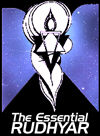 |
| Home | Bio | Art | Music | Literature | Civilization & Culture | Philosophy of Wholeness | Theosophy & Spirituality | Astrology |
 THE ESSENTIAL RUDHYAR
An outline and an evocation
by Leyla Raël 1983 I. FOUNDATIONS
II. CONCEPTUAL FORMULATIONS
1. The Experience of Change
2. Wholes in Time: Cycles 3. Wholes in Space: Entities 4. Wholeness 5. Holarchy & Dharma 6. Evolution & the Two-Way Cosmic Process 7. The Challenge of "Transfinite" Wholeness to Finite Wholes 8. Activity & Consciousness 9. The Principles of Unity & Multiplicity 10. The Movement of Wholeness 11. The Cycle of Being 12. Human Evolution & Reincarnation Within the Cycle of Being 13. The Constitution & Entire Cycle of Human Being 14. The Nature and Function of Mind 15. The Planetary Whole & the Place & Function of Human Evolution Within It 16. Rhythms of Culture & Civilization 17. The Process of Transformation 18. Transpersonal Activity 19. The Process of Deconditioning & Renewal
III. RUDHYAR'S
INTEGRATION OF EXPERIENCE AND CONCEPTS |

III. RUDHYAR'S INTEGRATION OF EXPERIENCE AND CONCEPTS
1. THE ARTS
A. POETRY
The following is quoted from the Foreword of Of Vibrancy and Peace (1967), an anthology of poems from 1916 to 1962: "My poetry was not written with the view of conforming to a literary tradition and to fit into esthetically appreciable forms. It is the quite spontaneous expression of my inner life; it was written in most cases of time of great stress, of challenging, perhaps devastating emotional and/or spiritual experiences. It was meant to express and to communicate the fervor and intensity of what psychologists now often call 'peak experiences' . . . "The poet [in the original sense of the Greek term] is he who acts as 'mover and shaker' of souls, stimulating his audience to feel more deeply, more totally than their ordinary lives allow . . . He opens new vistas, new levels of vision, new depths of relationship — of love, pain or ecstasy. He presents new images, connects in new ways until then distant facets of human experience. He evokes new dawns, expands man's consciousness — and man's eagerness to reach into the unknown." The following is paraphrased (interspersed with quotations) from Rudhyar's unpublished autobiography (1980): Poetry means something different in each period of a culture. "In the early stages of a culture's development poetry always has an essentially magical, epic or sacred character. Mantrams and magical or theurgic formulas are the initial sources of what later becomes epic and religious poetry." At first "poetry and music are hardly distinguishable." The poet is the bard who intones poems (linked with dramatic gestures) narrating the culture's myths and legends. The poet thus builds and later helps to maintain the collective psychism of the culture. Only when a culture reaches the Romantic phase of its development does the poet act as an individual for whom poetry is a means for 'self-expression. Instead of narrating the lives and deeds of legendary heroes, the poet becomes the central figure whose life, passions, sufferings and joys poetry reveal. This self-expression, however, also means 'self-revelation' — a veiling in symbolic forms what the poet has either experienced or is unable to act out. "The majority of my poems have exteriorized in symbolic words and images what in me had been unable to find manifestation in concrete everyday living and actual interpersonal relationships. They reveal potentialities whose actualization was but too often made impossible by the outer circumstances and/or inner pressures of my life. They reveal a level of my inner life which could be made concrete only in symbols rather than in actual physical happenings." "The reason for this is far more basic than one initially might think . . . A great many human beings . . . succeed relatively well in actualizing their birth potential, because the latter fits rather smoothly into the collective framework of family, culture, and religion . . . In times of transition between historical cycles and under special circumstances . . . other individuals are born with a far vaster potential of being than can be actualized at the time and in the place they were born. We say that they are 'ahead of their times, ' pioneers of a future type of consciousness and interpersonal relationship. The result is that they face the near-impossibility of actualizing their inner potential — their dharma, their essential being. As they are so often unable to resolve the tension of the polar forces within their personality in terms of actual and fulfilling experiences, they are driven by an inner power to produce a liberating solution at the symbolic level of literature or of another artistic or concept-formulating activity. "A culture having reached the last stage of its development needs such individuals. In a very real sense, their frustrations and apparent failures at the level of actual sociocultural happenings are the very roots of their spiritual successes as transformative agents. Through their attempts to provide concrete existential solutions to their actually insoluble inner tensions ... they create poems, music, paintings, etc., giving symbolic forms to future sociocultural processes. They thus release seeds of futurity — archetypes that eventually will become the paradigms of a new society and/or culture." By permission of Leyla Rudhyar Hill Copyright © 1983 by Leyla Raël All Rights Reserved.  Web design and all data, text and graphics appearing on this site are protected by US and International Copyright and are not to be reproduced, distributed, circulated, offered for sale, or given away, in any form, by any means, electronic or conventional. See Notices for full copyright statement and conditions of use. Web design copyright © 2000-2004 by Michael R. Meyer. All Rights Reserved. |
 |